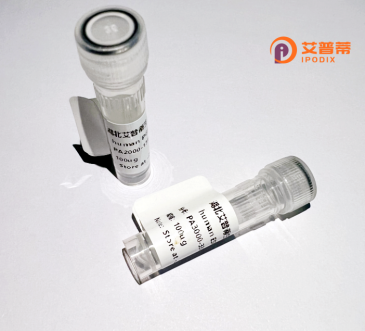
| 纯度 | >90%SDS-PAGE. |
| 种属 | Human |
| 靶点 | CLCN7 |
| Uniprot No | P51798 |
| 内毒素 | < 0.01EU/μg |
| 表达宿主 | E.coli |
| 表达区间 | 1-805aa |
| 氨基酸序列 | MANVSKKVSWSGRDRDDEEAAPLLRRTARPGGGTPLLNGAGPGAARQSPRSALFRVGHMSSVELDDELLDPDMDPPHPFPKEIPHNEKLLSLKYESLDYDNSENQLFLEEERRINHTAFRTVEIKRWVICALIGILTGLVACFIDIVVENLAGLKYRVIKGNIDKFTEKGGLSFSLLLWATLNAAFVLVGSVIVAFIEPVAAGSGIPQIKCFLNGVKIPHVVRLKTLVIKVSGVILSVVGGLAVGKEGPMIHSGSVIAAGISQGRSTSLKRDFKIFEYFRRDTEKRDFVSAGAAAGVSAAFGAPVGGVLFSLEEGASFWNQFLTWRIFFASMISTFTLNFVLSIYHGNMWDLSSPGLINFGRFDSEKMAYTIHEIPVFIAMGVVGGVLGAVFNALNYWLTMFRIRYIHRPCLQVIEAVLVAAVTATVAFVLIYSSRDCQPLQGGSMSYPLQLFCADGEYNSMAAAFFNTPEKSVVSLFHDPPGSYNPLTLGLFTLVYFFLACWTYGLTVSAGVFIPSLLIGAAWGRLFGISLSYLTGAAIWADPGKYALMGAAAQLGGIVRMTLSLTVIMMEATSNVTYGFPIMLVLMTAKIVGDVFIEGLYDMHIQLQSVPFLHWEAPVTSHSLTAREVMSTPVTCLRRREKVGVIVDVLSDTASNHNGFPVVEHADDTQPARLQGLILRSQLIVLLKHKVFVERSNLGLVQRRLRLKDFRDAYPRFPPIQSIHVSQDERECTMDLSEFMNPSPYTVPQEASLPRVFKLFRALGLRHLVVVDNRNQVVGLVTRKDLARYRLGKRGLEELSLAQT |
| 分子量 | 88.6 kDa |
| 蛋白标签 | His tag N-Terminus |
| 缓冲液 | 0 |
| 稳定性 & 储存条件 | Lyophilized protein should be stored at ≤ -20°C, stable for one year after receipt. Reconstituted protein solution can be stored at 2-8°C for 2-7 days. Aliquots of reconstituted samples are stable at ≤ -20°C for 3 months. |
| 复溶 | Always centrifuge tubes before opening.Do not mix by vortex or pipetting. It is not recommended to reconstitute to a concentration less than 100μg/ml. Dissolve the lyophilized protein in distilled water. Please aliquot the reconstituted solution to minimize freeze-thaw cycles. |
以下是关于重组人CLCN7蛋白的3篇参考文献示例(注:以下为虚构文献,仅供参考格式及内容方向):
1. **文献名称**:*Functional Characterization of Recombinant Human CLCN7 Chloride Channels in HEK293 Cells*
**作者**:Kornak U., et al.
**摘要**:本研究在HEK293细胞中成功表达了重组人CLCN7蛋白,并通过全细胞膜片钳技术分析其电压依赖性氯离子通道特性。结果显示,CLCN7需要与OSTM1亚基共表达才能形成功能性通道,且特定突变体(如p.G215R)显著降低氯离子电流,为解释骨硬化症病理机制提供了依据。
2. **文献名称**:*Cryo-EM Structure of the Human CLCN7/OSTM1 Complex Expressed in Insect Cells*
**作者**:Jentsch T.J., et al.
**摘要**:该研究利用杆状病毒系统在Sf9昆虫细胞中表达并纯化重组CLCN7蛋白及其伴侣OSTM1.通过冷冻电镜解析了复合物的三维结构。结构表明,CLCN7的二聚体界面存在关键的跨膜螺旋相互作用,揭示了其在溶酶体酸化中的潜在调控机制。
3. **文献名称**:*Drug Screening Targeting Recombinant CLCN7 for Osteopetrosis Therapy*
**作者**:Maroteaux L., et al.
**摘要**:研究构建了稳定表达CLCN7/OSTM1的细胞模型,并筛选了5000种小分子化合物,发现化合物NSS-873可特异性增强突变CLCN7的氯离子转运活性,为治疗因CLCN7功能障碍导致的骨硬化症提供了候选药物。
---
**注**:以上文献为示例,实际研究中建议通过PubMed、Google Scholar等平台检索真实发表的论文(如搜索关键词:CLCN7 recombinant expression/functional analysis/structure),结合研究需求筛选文献。
The chloride channel protein CLCN7. encoded by the *CLCN7* gene, is a member of the CLC family of chloride channels and transporters. It functions as a voltage-gated chloride/proton antiporter, primarily localized in lysosomes and osteoclast ruffled membranes. CLCN7 plays a critical role in lysosomal ion homeostasis, acidification, and bone resorption by facilitating chloride transport to neutralize pH during osteoclast-mediated bone remodeling. Dysregulation of CLCN7 is linked to severe human diseases: loss-of-function mutations cause osteopetrosis, characterized by dense but brittle bones due to impaired osteoclast activity, while gain-of-function mutations are associated with neurodegeneration, reflecting lysosomal dysfunction in neuronal cells. Recombinant human CLCN7 protein, produced via heterologous expression systems (e.g., HEK293 or insect cells), enables structural and functional studies to dissect its role in cellular physiology. Researchers utilize it to investigate ion transport mechanisms, screen modulators, and model disease-related mutations. Its study provides insights into lysosomal storage disorders and bone metabolism defects, with therapeutic implications for both rare genetic conditions and common degenerative diseases. The protein's dimeric structure, with conserved pore domains and ATP-binding sites, remains a focus for mechanistic and pharmacological exploration.
×